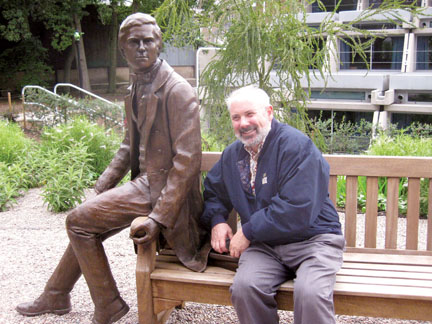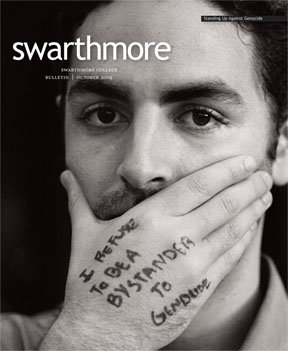Evolution Evolves

While attending festivities in Cambridge, England, in honor of Charles Darwin’s 200th birthday, Scott Gilbert was able to share a bench with the great man himself, rendered in bronze as a Cambridge undergrad in the 1830s pondering his still uncertain future. Earlier in the year, Gilbert was also invited to speak at a Vatican conference on evolution.
“It’s been a big year for Darwin!” says Howard A. Schneiderman Professor of Biology Scott Gilbert. And it hasn’t been too bad for Gilbert either. He has become a spokes-person for “evolutionary developmental biology,” a new discipline that studies how changes in embryonic development can create new anatomical structures that can be selected.
In March, in honor of the 200th birthday of the naturalist whose 19th-century theory of natural selection revolutionized biological science, a papal conference, organized by the Pontifical Gregorian University in collaboration with Indiana’s University of Notre Dame, was held at the Vatican. Titled “Biological Evolution, Facts and Theories: A Critical Appraisal 150 Years After The Origin of Species,” the conference assembled an illustrious collection of scientists, philosophers, and theologians, with the aim of promoting a fair and productive relationship between the three disciplines. Gilbert, one of the invited speakers, talked about “Evolutionary Developmental Biology: Evolution by Epigenesis.”
“This was a very worthwhile meeting,” Gilbert says. “It focused on two problems, the first of which is concerned with the relative roles of competition and cooperation for the creation of a new species…. While competition is critical for the survival of the fittest, the arrival of the fittest, i.e., the mechanisms by which such species are generated, may have more to do with cooperation than competition. The second problem concerned whether there was any trait or character that is strictly human and not found in at least a rudimentary stage in nonhuman primates. This was the challenge given to the physical anthropologists [at the conference]. I came away thinking that one thing that characterized humans to the exclusion of other apes is that they told and enjoyed good stories.”
In July, Gilbert was invited to the four-day “Darwin 2009: A Festival,” held at Cambridge University, England, where Darwin’s great-great-granddaughter Ruth Padel, a poet, was also present. In a session titled “The Changing Views of Evolution,” Gilbert, with six other scholars from around the world, explored the role of organisms that, having been selected by natural forces for survival and reproduction, must continue to evolve and produce descendants. Their goal was to assess how current evolutionary theory can explain organisms’ mate choices, adaptability, and their ability to further evolve.
Besides pontificating in Rome and partying in Cambridge this summer, Gilbert has received good reviews for the December 2008 book Ecological Developmental Biology: Integrating Epigenetics, Medicine, and Evolution that he co-authored with David Epel, a developmental biology professor at Stanford University. Recognized as world experts in the emerging field of “eco-devo,” the authors discuss ways in which the environment affects the origin and evolution of organisms, presenting an all-inclusive view of biology that illustrates the inter-connectedness of ecology, development, health science, molecular genetics, and evolution.
Gilbert’s most recent study with Judy Cebra-Thomas, a developmental biologist at Millersville University, resulted in the discovery of a genetic link in the evolution of the heart from three chambers to four chambers, illuminating part of the puzzle of how birds and mammals became warm-blooded. The research garnered them a cover story in Nature magazine.
 Email This Page
Email This Page